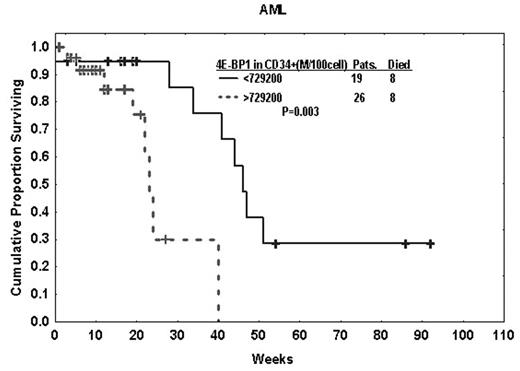Abstract
The mammalian target of rapamycin (mTOR) is a serine/threonine kinase involved in the regulation of cell growth and proliferation. Once activated, mTOR can phosphorylate its downstream targets. One of these targets is the 4E-binding protein 1 (4E-BP1), which is phosphorylated and inactivated by mTOR in response to a growth signal. Phospho-4E-BP1 dissociates from the eukaryotic initiation factor 4E (eIF-4E), a translation initiation factor that subsequently binds the cap structure of 5′ mRNAs and initiates the translation of transcripts encoding genes involved in cell cycle control. Rapamycin and its analogs are immunosuppressant drugs that exert their activity by specific inhibition of mTOR. mTOR inhibition induces cell cycle arrest not only in normal lymphocytes but also in malignant cells. Using flow cytometry, we quantified the levels of 4E-BP1 and phosopho-4E-BP1 in CD34+ and CD3+ cells from bone marrow samples collected from patients with acute myeloid leukemia (AML) or myelodysplastic syndrome (MDS). We then measured the antibody binding capacity of 100 CD34+ or CD3+ cells using QuantiBRITE and PE (phycoerythrin)-labeled antibodies in a 1:1 ratio. We demonstrated that CD34+ cells express significantly higher levels of 4E-BP1 (P=0.005) and phosphor-4E-BP1 (P=0.0001) as compared with CD3+ cells in patients with AML (n=49). In contrast, there was no significant difference in the levels of 4E-BP1 or phospho-4E-BP1 between CD34+ and CD3+ cells in patients with MDS (n=15). More importantly, in patients with AML, high expression of 4E-BP1 in CD34+ cells was associated with shorter survival (P=0.003) as well as shorter complete remission duration (CRD) (P=0.03). This association between survival and levels of 4E-BP1 was independent of cytogenetic abnormalities in this group of patients. This data not only suggests that the 4E-BP1 level, as measured in the CD34+ cells, can be an important prognostic indicator in AML but also suggests that 4E-BP1 plays a role in the biology of AML. Furthermore, targeting 4E-BP1 by mTOR inhibitors, or other means of down modulating 4E-BP1 levels, is a rational therapeutic approach in AML.
Author notes
Corresponding author


This feature is available to Subscribers Only
Sign In or Create an Account Close Modal